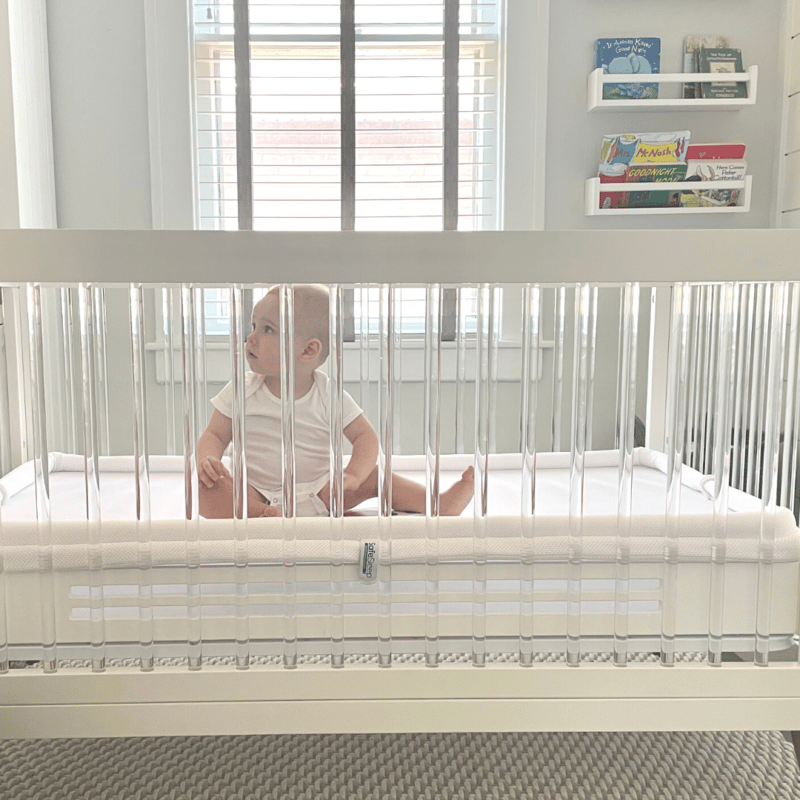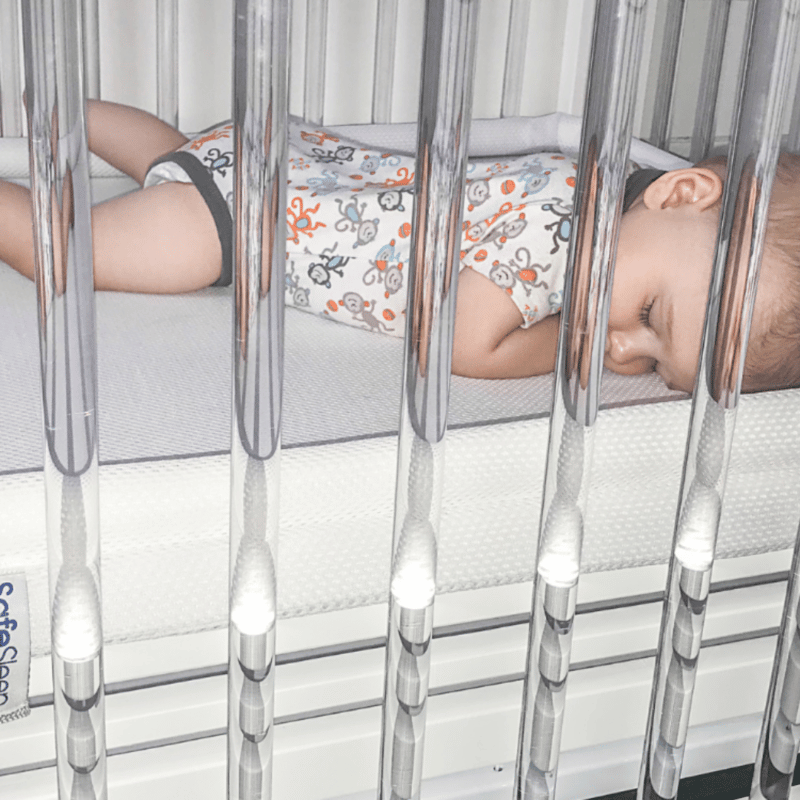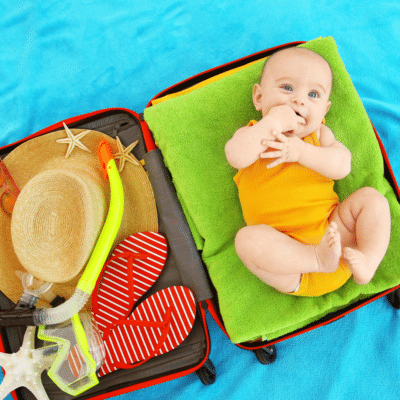No products in the cart.
Sleep Tips to Help Your Baby Sleep Longer and Better
Sleep is truly the foundation to everything in your family and especially when you have kids. When babies are waking up often or not sleeping well everything becomes unbalanced – your health, your marriage/relationship, your child’s ability to thrive and develop, your work, and truly every aspect of your life. These baby sleep tips are sure to help!
I’ve experienced severe sleep deprivation after having a baby and tried everything to help. I solicited baby sleeping advise from anyone who would listen. I even resorted to co-sleeping which is VERY SCARY – an extremely tired mom sleeping with a baby is a HUGE NO-NO. I knew it was wrong. I felt so guilty, but at the time, I thought it was the only way to get my baby to sleep.
Where Will Baby Sleep?
Have a plan on where baby will sleep. You can opt for a bassinet or go right to using a crib. If you choose to use a bassinet, once they begin to roll, transition them to a crib with a breathe-through crib mattress. After finding my baby face down on the mattress after rolling in the middle of the night, I panicked.
I asked my pediatrician what to do. She recommended the SafeSleep® Breathe-Through Crib Mattress. I knew breathable crib mattresses existed, but I did not know a breathe-through crib mattress was an option.
The Breathe-through crib mattress is very different than a breathable crib mattress. It is the best baby sleep tip I received.

Around the age of 4 months, baby’s circadian rhythm is fully developed, but still immature. It’s the perfect time to ensure your baby learns self-soothing and healthy sleep habits.
Creating a Bedtime Routine
Creating a soothing bedtime routine for your child isn’t always easy but it’s crucial for your baby’s health and development. Creating a soothing bedtime routine should start with nightly rituals that are consistent each night before bedtime so your baby will start learning sleep cues.
Once a soothing bedtime routine is established, your baby will start feeling sleepy each time you start these activities and will be ready for bed in no time. The key is to make sure the routine includes soothing activities to calm your baby down so he/she will be prepared to sleep!
Tone it Down
15 minutes before you start creating a soothing bedtime routine, take it down a notch. Dim the lights, turn off the TV and other electronics, and use quieter voices. This will start to soothe baby.
Start with a Bath
Many parents start off creating a soothing bedtime routine with a bath because it’s such a soothing activity and a great way to wind down for the night. The feeling of the warm water and being massaged with soap is so relaxing for baby.
A bath should be 5-10 minutes (if any longer this could actually stimulate the baby instead). Dry baby off with a soft towel and then have a quick cuddle before putting on PJs.
Set up the Nursery
After the bath you will be bringing baby to the crib in his/her nursery so you want to make sure the perfect sleep environment is all set up and ready. Have a nightlight on for when you come in from the bath so the lights are low, but never keep the nightlight on during night sleep as babies need darkness to produce the sleep hormone.
Plus a light is stimulating. A good way to make sure the room is super dark is to use blackout curtains or black trash bags work great too. Once baby is in the crib, turn on the sound machine and make sure it’s on the white noise setting that is constant.
No rain, waves or other sounds that go up and down with pitch as this is also stimulating for baby. Next, you will want to remove any blankets or toys from the crib making sure all that’s left is your properly dressed baby.

The Ideal Sleep Environment
Dark Room
This is very important. Any type of light will stimulate baby and keep them awake. No nightlights and even the little light on the sound machine should be covered up. Room darkening shades or curtains work great, and can add some flair to the nursery.
Empty Crib
No mobiles with music, no musical or light projector toys, no pillows, no blankets, no bumpers, no toys, or anything else should be inside the crib. Only your swaddled baby.
Temperature
The optimal temperature for infant sleep is between 65 and 70 degrees Fahrenheit. Overheating is a risk factor if SIDS and it’s very important to keep baby the right temperature – not too hot and not too cold.
Using a ventilated Woombie baby swaddle on hot/warm nights helps keep the air circulating over baby’s skin and in the winter try the Winter Woombie swaddle which has more warmth. and also the SafeSleep crib mattress is designed to keep air flowing so baby does not get too hot or too cold.
Use a Breathe-Through crib mattress
a breathe-through crib mattress. A breathe-through crib mattress is an important part of creating a soothing bedtime routine for your baby.
A breathe-through crib mattress gives your baby the safest, most comfortable sleep. It also give parents peace of mind knowing that baby will be able to breathe normally through the mattress if he/she rolls over onto their stomach in the middle of the night.

Want more safe sleep tips? Read Safe Sleep for Infants – Do’s and Don’ts
Put on pajamas/swaddle
Creating a soothing bedtime routine includes soft and comfy pajamas made from materials like organic cotton and bamboo are very soothing as they feel silky against baby’s skin.
If your baby is still being swaddled, try using a zip-up swaddle that is ventilated like the breathable Woombie Air. The two-way zipper makes it easy and quick to put on so you won’t stir baby who may already be falling asleep (and it makes for easy diaper changes in the middle of the night!)
Story time
Story time is a pretty traditional way of creating a soothing bedtime routine; it is relaxing and a great way for parents to bond with their children. You may think it is silly to read your baby a bedtime story when baby cannot understand it yet, but reading to baby will have a big impact on his/her language development.
Plus, hearing your soothing voice will also be helpful in putting baby to sleep. I’ve read to my baby since birth and now at 15 months he chooses his bedtime book and turns the pages.
Place baby to sleep
It’s important for parents to put baby in the crib to sleep before baby is fully asleep. Creating this soothing bedtime routine helps your baby learn to fall asleep on her own without relying on mom or dad to rock her to sleep each night.
During the time while baby is in the crib but still not asleep you can sing to her or say a phrase like “Night, night” as a sleep cue. Say this confidently and exit the room. If baby cries don’t rush right in. Give it 10 minutes to see what happens. You want your baby to learn how to self-soothe. This is so important.

It’s never too early (or too late) to sleep train
Starting sleep training early is definitely a good idea, but it is possible to start too early. During the first few months of your child’s life, he/she will spend most of their time sleeping.
You don’t want to do anything to disrupt their sleep and keep them awake when their body needs sleep just so that you can get baby to sleep on your schedule. This can end up having a serious negative effect on baby’s development.
According to our friends over at SleepWell Baby certified child sleep consultants, a baby can begin sleep training at four months of age.
Why four months? Well, it’s all based on baby’s internal biological clock. We all operate on internal 24-hour clocks, which are genetically controlled. These clocks drive our circadian rhythms to tell our bodies when we should be sleeping.
As baby adjusts to the day’s darkness and daylight, a baby develops their own circadian rhythm at four months of age. “If we overlook their need to sleep during the times when their body temperature dips and melatonin production increases, we see babies who do not settle easily or sleep for long stretches.
With this said, it’s also never too late to start sleep training. For example, I started sleep training with my son at nine months old (After 16 long weeks of hoping and praying his constant night waking would end, but guess what?
They only got worse as time went on!). We saw immediate results after working with SleepWell Baby and our son now sleeps 12 hours a night and two 2-3 hour naps a day like clockwork.
Don’t Add Rice Cereal to Your Baby’s Formula
The idea behind this baby sleep myth is that if you add rice cereal to your baby’s bedtime feeding, baby will stay full longer and therefore sleep longer through the night.
The truth is, it’s just not safe to give a baby under four months old rice cereal because their digestive system can’t handle it. Some pediatricians even recommend no solids until six months and no grains until 12 months.
Giving baby rice cereal at such a young age could cause tummy trouble which can keep baby awake and increase crying. Additionally, young babies need to eat every two to three hours so trying to get a baby to remain full for a longer period of time prevents baby from getting the nutrition they need to grow and thrive. As a mother I know it’s not easy to get up every two to three hours during the night, but it does not last forever and you will get through it. We must do what is best for our babies.
by ready to go longer without night feedings? A good rule to follow is if baby is gaining weight and weighs at least 15 pounds then baby is able to sleep 12 hours a night with no feedings.
Don’t worry that your baby won’t get enough nutrition because another cool thing I learned about babies is that they self-regulate their own bodies! When we started sleep training we went from 24 ounces of formula a night to no bottles at night COLD TURKEY and we noticed that our baby started eating more during the day instead.
It’s truly incredible. We were so uneasy about stopping night feeding like that so suddenly, but we trusted our sleep consultant and they were right! Our baby did not wake up or cry to eat. He slept 6 hours straight the first night of sleep training and then 11 hours straight on night two and then since then 12 hours straight every night.
Make Noise
You don’t have to keep quite. This is something that is constantly being said about a new baby, especially when visitors are over. Of course, you don’t want to go around making a huge racket, but babies are actually used to hearing loud noises from inside the womb.
Baby finds these noises to be comforting, which is why white noise machines are recommended as a nursery must-have. Let your child get used to sleeping while the rest of the household is up and about making typical noises.
Choose a white noise setting that is constant and does not have high and low pitches. Choosing a sound like ocean waves or rain is actually stimulating for baby which can keep baby awake.
Also, place the sound machine across the room on medium so that it’s not right next to baby’s ears.
Choose a Bedtime and Stick to it
Schedule is another crucial baby sleep tip . Sticking to a sleep schedule is and important part of creating an amazing sleeper. There are many baby sleep myths that parents often believe.
Depending on baby’s age there are certain windows of time that parents must follow to give baby optimal, healthy sleep. If baby stays awake past that window of time, they produce the hormone cortisol which makes it harder for baby to fall asleep.
Also, skipping naps does not make baby more tired for night sleep! Again, it works exactly the opposite. Remember sleep begets sleep.
Use a Crib Mattress that Promotes Longer, Better, and Safe Sleep
Most young infants have difficulty regulating their body temperature. This is especially true for premature and low-birth-weight infants.
Crib mattresses with fiberfill, quilted toppers, mattress pads, and vinyl covers can artificially elevate your infant’s temperature while sleeping.
This may cause infants to overheat – a know SIDS risk factor. The SafeSleep® Crib Mattress keeps your baby’s body core temp stable for a safer and longer sleep.
The air permeable, 3-D open celled SafeSleep® Topper helps keep your baby’s core body temperature stable – not too hot and not too cold. A stable core body temperature results in a longer, better, and safer sleep for your baby and longer, better sleep for you.
No more worries about your baby waking up from being too hot or too cold, the SafeSleep Crib Mattress helps regulate their ideal body temperature for them!
The SafeSleep Breathe-Through Crib Mattress is endorsed by leading pediatricians and safe sleep policy makers.

Conclusion
Healthy and safe sleep is the foundation of every family. Getting the ideal sleep for you and your baby, helps your baby thrive and develop. If baby is sleeping well, this means parents are too.
- Newborns sleep 16 to 18 hours per 24 hour day. This is the ideal sleep time for babies.
- Babies wake up often because their stomachs are small and get hungry again.
- Newborns have two different kinds of sleep: Active Sleep and Quiet Sleep. Both are considered healthy and safe sleep for baby. During active sleep, newborns move around a lot and make noises. They can be woken easily during active sleep. During quiet sleep, newborns are still. Their breathing is deep and regular. They’re less likely to wake during quiet sleep.” (Source)
- A newborn’s sleep cycle is 40 minutes long. After each sleep cycle your baby may start to cry and need help to go back to sleep. Holding baby or rocking helps.
- Around 3 or 4 months babies start to form sleep habits. So if you rock your baby to sleep, this is the time where you want to lay baby in the crib sleepy but not totally asleep so that baby can learn how to self-soothe and fall asleep on their own. The earlier the better than you start with this. If your baby is older and is still waking up multiple times a night needing you to rock him or her to sleep.
- Also, around the 4 month mark, your baby will be sleeping longer (4 to 6 hours straight). All babies are different however.
It’s amazing how much better babies sleep when following these tips. Our son is 3.5 and is still a rock-star sleeper.
Do you have a baby who hiccups a lot? Find out the advantages by reading, Baby Hiccups and Sleep.
Related Posts










